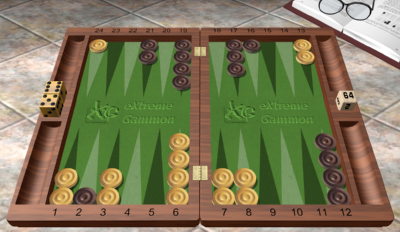In this position we’re still in the early part of the game. Both sides have one checker back. White has a somewhat impure structure with the ace-point already made, but he does have an extra inner point, plus a lot of checkers that can join in an attack. Black has only two inner points, but a very nice structure, with plenty of builders poised to make priming points. The position might appear at first to be evenly balanced, save for the small matter that White is on roll.
White on roll, center cube.

(a) Cash game. Should White double? If White doubles, what should Black do?
(b) Match, score tied 1 to 1 to 5 points. Same question.
(c) Match, White leads 2 to 1 to 5 points. Same question.
(d) Match, White leads 3 to 1 to 5 points. Same question.
Let’s start with the money game question, and look at our Sylvester Rule criteria:
(a) Race: White has a solid 28-pip lead, 112 to 140.
(b) Position: Edge to Black, who is well-placed to build a prime, while White is forced to play an attacking/racing game.
(c) Threats: White is on top here. It’s his roll, and his doubles all put Black in the air. In addition, 5-4 and 6-4 make the 2-point, 6-2 hits in the outfield, and 24/13 escapes to the midpoint. That’s 14 great shots; in addition, no roll is really bad.
It’s an early position, and we’ve got a solid lead in two out of three criteria, so by Sylvester’s Rule the position should be double and take. Rollouts show that’s correct. In fact, these decisions are so clear that it’s actually a ‘blunder/blunder’ position: not doubling is a blunder (error of 0.18 by Snowie, 0.17 by XG) and not taking is also a blunder (error of 0.18 by Snowie, 0.20 by XG). Blunder/blunder positions are uncommon but worth studying and committing to memory. When you get one wrong, it’s clearly a position you need to master. In this case, it’s worth remembering that in a cubeless game, White wins about 30% gammons, 34% single games, and loses about 36%. In a game with a cube, Black wins a few more games than this, with most of those extra wins coming from White’s single wins.
What happens, however, when this position occurs in a match?
Let’s start with the easiest case, which is (d): the score is 3-1 to 5 in favor of White, or 2-away 4-away. At this score, Black would trail 4-1 to 5 (Crawford) if he passes a double, and match equity tables make him about 17% to win the match in this case. (He needs to win three games in a row if he wins a single game at Crawford, and two games in a row if he wins a gammon in the Crawford game.) Clearly Black will take and reship if he’s given the cube in a position he can win more than 17% of the time cubeless. Since his winning chances here are about 36% cubeless, it’s a trivial take and reship on his part. With White’s high gammon chances, it’s a huge blunder for him to redouble. He should just play on and see if he can win the match with an undoubled gammon.
At this score, White only wants to double positions with high winning chances (better than about 80%) but very low gammon chances. As a practical matter, this means he leaves the cube alone when there’s any significant contact, and only doubles in races and certain high anchor positions where he has a huge racing lead.
The next easiest case is (b): the score is tied at 1-1 to 5, or 4-away 4-away. Many players are fooled by this score, since it seems that the end of the match is still fairly far away, and therefore the cube action should be like a normal money game. But that’s a mistake. Winning a gammon here actually wins the match by an exact count, which is exceptionally valuable. The easiest way to see just how valuable is to compare what happens when White wins a gammon in a money game to what happens when White wins a gammon at this match score.
In a money game, winning a gammon instead of a single gammon exactly doubles White’s profit: he goes from winning two points to winning four points, a 100% increase. At the 1-1 score, however, it’s a bit different. Winning a single game takes White from 1-1 to 3-1, and increases White’s match winning chances (MWC) from 50% to about 68%, a gain of 18%. Winning a gammon, however, wins the match, taking White from 50% to 100%, a gain of 50%. Gaining 50% instead of 18% is an increase of 32/18 = 178%, instead of just 100%.
That’s such a big difference that White should double and Black should actually drop! This result is typical of a lot of early blitz positions at the 4-away 4-away score: easy take for money, easy drop at the match score.
That leaves only case (c), the hardest case: White leads 2-1 to 5, or 3-away 4-away. This case is actually most similar to case (d). At 3-away 4-away, White’s gammons are largely (but not completely) crippled. The problem is that winning a single game takes White to 83% match winning chances, most of the way to his goal. Adding a gammon only gets him a little bit farther. As a result, White should mostly adopt the cube strategy of case (d): play for the undoubled gammon, and only cube if he becomes a bigger favorite with fewer gammon chances. It’s an easy take for Black, of course.





